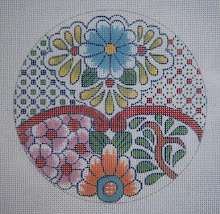 I have just put a short tutorial on Possibilities, etc. on the subject of the 4-way bargello on an egg, using the flowers I'm developing - great fun on a cold day while watching the History channel! I'll have the piece finished, hopefully, in a few days, and can post the charts and instructions here - but meanwhile, take a look at the other blog and maybe try it on your own. This is a detail of the center with the beginning of the 4-way "frame."
I have just put a short tutorial on Possibilities, etc. on the subject of the 4-way bargello on an egg, using the flowers I'm developing - great fun on a cold day while watching the History channel! I'll have the piece finished, hopefully, in a few days, and can post the charts and instructions here - but meanwhile, take a look at the other blog and maybe try it on your own. This is a detail of the center with the beginning of the 4-way "frame."
The blue flower has no leaves yet, as I'm tired, and need to study it tomorrow. - but here is the chart for the little pink one to keep you busy.


















































